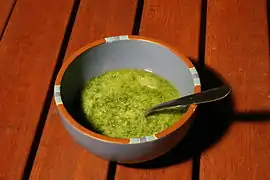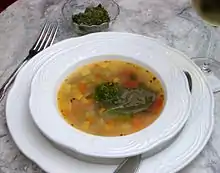Pistou
Pistou (Provençal: pisto (classical) or pistou (Mistralian), pronounced [ˈpistu]), or pistou sauce, is the French translation of the famous Genoese pesto following the annexation of Nice by France in 1860. It's a ligurian cold sauce made from cloves of garlic, fresh basil, and olive oil. It is somewhat similar to the Ligurian sauce pesto, although it lacks pine nuts. Some modern versions of the recipe include grated parmesan, pecorino, or similar hard cheeses.
 Small serving dish of pistou | |||||||
| Alternative names | Pistou sauce (pesto) | ||||||
|---|---|---|---|---|---|---|---|
| Type | Sauce | ||||||
| Place of origin | Italy | ||||||
| Region or state | Liguria | ||||||
| Serving temperature | Cold or Warm | ||||||
| Main ingredients | |||||||
| 209 kcal (875 kJ) | |||||||
| |||||||
| Similar dishes | pesto | ||||||
Etymology and history
In the Provençal dialect of Occitan, pistou means "pounded".[1]
The sauce is derived from the Genoese pesto, which is traditionally made of garlic, basil, pine nuts, grated Sardinian pecorino, and olive oil, crushed and mixed together with a mortar and pestle. The key difference between pistou and pesto is the absence of pine nuts in pistou.[2][3]
Use

Pistou is a typical condiment from the Provence region of France most often associated with the Provençal dish soupe au pistou, which resembles minestrone and may include white beans, green beans, tomatoes, summer squash, potatoes, and pasta. The pistou is incorporated into the soup just before serving.[4]
Gruyère cheese is used in Nice.[2] Some regions substitute Parmesan cheese. In Liguria, pecorino, a hard sheep's-milk cheese from Sardinia or Corsica is used. Whatever cheese is used, a "stringy" cheese is not preferred, so that when it melts in a hot liquid (like in the pistou soup, for instance), it does not melt into long strands.
See also
- Argentine chimichurri, a somewhat similar sauce made with parsley
- List of garlic dishes
- Persillade
References
- Wolfert, Paula (July 2006). "France's Best Pistou". Food and Wine.
In the Provençal dialect, pistou means 'pounded.'
- Root, Waverley (1992) [Originally published 1958]. The Food of France. New York: Vintage Books. p. 369. ISBN 0-679-73897-5.
It seems undoubtedly to have come from across the border from Italy, deriving from a Genoese sauce called pesto ... [made] by using a pestle and mortar to mash together leaves of sweet basil, Sardinian sheep's milk cheese, butter, garlic, and olive oil ... The Nice formula ... uses cheese of the Gruyère type.
- About French Food. Pistou...or pesto? Debra F. Weber Archived 2006-10-26 at the Wayback Machine
- Root, Waverley (1992) [Originally published 1958]. The Food of France. New York: Vintage Books. pp. 369–370. ISBN 0-679-73897-5.
The soup in which the pistou is placed, giving it its flavor and its name, is a form of minestrone. One Nice recipe gives the vegetables that go into it as white beans, tomatoes, and summer squash. Another names string beans, potatoes, tomatoes, and vermicelli [Into the soup] you put the pistou ... at the very last moment.
.jpg.webp)